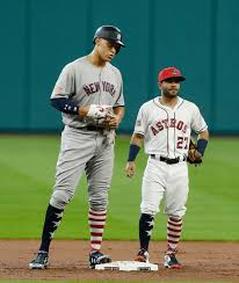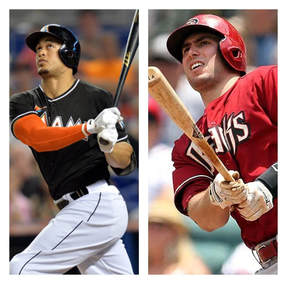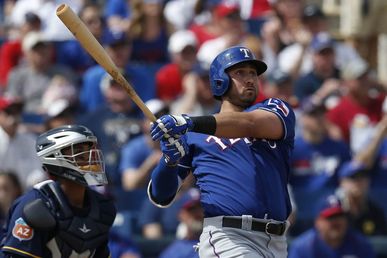 by Julian Spivey I don’t have a vote for Most Valuable Player in baseball, but if I did here would be the top five on my American League ballot and the reasons why I chose these five players … 5. Jose Ramirez (Cleveland Indians) Jose Ramirez in the span of about two seasons has gone from a utilityman to one of the most underrated stars in the American League for the Cleveland Indians. Ramirez was the Indians most consistent offensive player this year and did so playing all over the field splitting time between second and third base this year. Ramirez hit .318 (fourth in the league) with 29 home runs 83 RBI. His 186 hits were good enough for fifth in the A.L., as well. 4. Mike Trout (Los Angeles Angels) It’s a testament to how truly great Mike Trout is that he could only play in 114 games and still be among the five best players in his league. Trout hit .306 this season with 33 homers, 72 RBI and 22 stolen bases. Trout led the American League in slugging and on-base percentage and his 6.4 WAR was the third best in the league. 3. Corey Kluber (Cleveland Indians) Cleveland Indians ace Corey Kluber was arguably the best pitcher in all of baseball this year and should be the front-runner for his second Cy Young Award. Kluber led the A.L. with a 2.25 ERA and his 18-4 win-loss record was the best in baseball. His 265 strikeouts were second to only Boston Red Sox ace Chris Sale in the A.L. 2. Aaron Judge (New York Yankees) Aaron Judge came out of nowhere this year for the New York Yankees to stun Major League Baseball. There is a very good chance that Judge could join only Fred Lynn and Ichiro Suzuki as players to win both Rookie of the Year (for which he’s a lock) and MVP in the same season. Judge led the American League with 52 home runs, a new rookie record. His 114 RBI were second in the A.L. to Seattle Mariners designated hitter Nelson Cruz. Judge also hit a very respectable .284 and led the A.L. with an 8.8 WAR. His only downfall was leading the league in strikeouts and a sizeable drought during the second half of the season. 1. Jose Altuve (Houston Astros) It wouldn’t surprise me if Aaron Judge wins the MVP based on a stunning rookie season and mostly an East Coast/New York bias, but I believe Houston Astros diminutive second baseman Jose Altuve should be the MVP. Altuve has won the American League batting title for three consecutive years and is still somewhat underappreciated. He led the A.L. this year with a .346 average, which is 16 points higher than the next guy (Avisail Garcia). Altuve’s power numbers continue to rise with him hitting 24 homers and driving in 81 runs this season while also being one of the game’s best speedsters with 32 stolen bases, third in the A.L.
0 Comments
 by Julian Spivey I don’t have a vote for Most Valuable Player in baseball, but if I did here would be the top five on my National League ballot and the reasons why I chose these five players … 5. Charlie Blackmon (Colorado Rockies) Sure, his offensive numbers are likely aided by playing at Coors Field in Denver, but Charlie Blackmon’s numbers from the leadoff spot simply can’t be ignored. Blackmon set the record for most RBI from the leadoff spot this season with 104, breaking Darin Erstad’s record. He also hit 37 home runs while winning the National League batting title with a .331 average. 4. Max Scherzer (Washington Nationals) I believe Washington Nationals ace Max Scherzer should be the National League Cy Young winner this season as the N.L.’s best pitcher, but I also believe he should receive some MVP votes (which I know is controversial for some). Scherzer was the league’s most dominant pitcher this year compiling a 16-6 win-loss record with a 2.51 ERA (second in the league behind Clayton Kershaw) and a league high 7.2 WAR for pitchers. 3. Nolan Arenado (Colorado Rockies) It might be controversial to have two Colorado Rockies on my MVP ballot top five, but the Rockies did surprise many this year by winning the second wild card in the National League and making the playoffs. It’s hard to argue with Arenado’s offensive numbers and he’s also a gold glove defender. Arenado finished third in the N.L. with 37 homers and second in the league with 130 RBI while hitting over .300. Arenado has hit 37 or more homers in each of the last three seasons. 2. Paul Goldschmidt (Arizona Diamondbacks) Arizona Diamondbacks first baseman Paul Goldschmidt is the seemingly popular pick to win the National League MVP award this season with terrific all-around numbers that include 36 home runs (fourth in the league), 120 RBI (fourth in the league) and a .297 average. Goldschmidt led the surprising Diamondbacks to a playoff appearance this season and has been one of the most underrated players in baseball for much of his career. 1. Giancarlo Stanton (Miami Marlins) Some people have a bias where they don’t believe players on teams that miss out on postseason don’t deserve to win the MVP award. In most case I believe the MVP should come from a playoff team, but Giancarlo Stanton’s 2017 offensive numbers were out of this world. Stanton hit 59 home runs, the third most all-time by a non-PED user. His 59 homers were a whopping 20 more than the runner-up in his league (Cody Bellinger). Stanton’s 132 RBI also led his league and his .281 average was 13 points higher than his career average. His 7.6 WAR also led the N.L.  by Julian Spivey I believe it was about month ago I had a Texas Rangers game on the television while I was working on other stuff, as I often do with random sporting events, and Joey Gallo – who bounced between third base, first base and outfield this year for the Rangers – launched a moonshot. It was number thirtysomething on the year for him and I texted my friend Bobby, as I often do random baseball stats throughout the day, that Gallo was on pace for the worst 40 home run season in baseball history. I didn’t have the stats before me now, but he was hitting around the Mendoza line (.200) and almost half of his base hits on the year had left the park. I couldn’t imagine a 40-homer season being any worse and I’ve lived through the career of Adam Dunn. In the Rangers penultimate game of the season on Saturday against the Oakland A’s Gallo, who looked for a while like he might come up short of the 40 number, hit home runs No. 40 and 41 on the year. They were his 93rd and 94th base hits of the season. He didn’t play in the Rangers final game of the season on Sunday, but if he had he would’ve needed six hits just so as not to become the first player in baseball history to hit 40-plus homers without reaching 100 hits on the season. This brings up the question I posed to Bobby about a month ago: is Joey Gallo’s 2017 season the worst 40-homer season in baseball history? It’s not the easiest question to answer, honestly, because baseball is no longer a game of if you hit for a high average and drive a lot of runs in you’re having a good year. In the sabermetrics world you can strikeout 208 times like New York Yankees rookie slugger Aaron Judge did this season and have a WAR (Wins Above Replacement) of 8.0 and potentially win a MVP Award. Still, I looked up a bunch of bad to terrible 40 home run seasons to determine what I felt was the worst of all-time, which honestly wasn’t that hard because most such seasons have been done in the last two decades of the game. I settled upon three 40-plus homer seasons to decide upon as the worst of all-time, each of which have come within the last six seasons. Those seasons were Adam Dunn’s 2012 year for the Chicago White Sox, Chris Carter’s 2016 season for the Milwaukee Brewers and, of course, Gallo’s season this year. Here are some numbers I’ve highlighted for those three seasons: Adam Dunn (2012): .204 average, 41 home runs, 96 RBI, 110 hits, 222 strikeouts, .800 OPS and 1.4 WAR Chris Carter (2016): .222 average, 47 home runs, 94 RBI, 122 hits, 206 strikeouts, .821 OPS and 0.9 WAR Joey Gallo (2017): .209 average, 41 home runs, 80 RBI, 94 hits, 196 strikeouts, .869 OPS and 3.1 WAR It should be noted right away that if you’re into sabermetrics and not much else you’re probably going to want to eliminate Gallo’s season from contention right away because his OPS (On-base plus slugging percentage) is quite a bit better than Carter or Dunn’s. You’ll also note his WAR is more almost two points higher than that of the other two seasons. There are two things I absolutely can’t get over with Gallo’s season: as previously mentioned it’s the only 40-homer season in baseball history in which the batter didn’t have 100 hits. Getting hits would seem to be the most basic thing about baseball. Well, that’s actually getting on base. Gallo and Dunn’s seasons had an identical .333 OBS (on-base percentage) and Carter had slightly less .321. It should be noted that Dunn did lead the American League in walks in 2012 with 105, despite the fact he couldn’t hit a lick with a .204 batting average (the worst average of any 40-homer season I could find). Dunn also led the A.L. in strikeouts that season with 206. Gallo did not lead the A.L. in striking out this year. He struck out 196 times compared to Judge’s 208, but it should be noted that Judge had almost 100 more at-bats this season than Gallo. How many more strikeouts would Gallo have had with those extra ABs? How many more homers would he have hit too? Many modern-day baseball stats nerds don’t value the RBI (run batted in). I understand this because it can be an inflated statistic. The number of RBI a player has is dictated by the number of teammates he has on base in front of him to drive home. Gallo only had 80 RBI this season, which is also the lowest number of RBI in MLB history for a 40-homer season and a whopping 12 fewer than the next lowest number, which was Adam Dunn’s 92 for the Cincinnati Reds in 2006 (maybe the fourth worst 40-homer season in baseball history based on my research). Here’s the thing though the Rangers were in the top 10 in the league in runs scored this season, and have the most of any time that didn’t make the playoffs and scored more than the Boston Red Sox and Los Angeles Dodgers, which won the A.L. East and N.L. West divisions respectively. I don’t know if the guys directly in front of Gallo in the lineup just had the bad knack for not being on the pond when he came to the plate, but I’ve got to feel he had plenty of opportunities to drive in more runs. Also, I still value the RBI more than most. Maybe I’m too old school, but that’s me. So, how should I decide which 40-homer season is the worst of all-time? This may be a little too simplistic, but what I’ve done is I’ve taken the three seasons from Gallo, Carter and Dunn and the key statistical categories listed above and given the three hitters a rank from first to third in each category. I then added those five categories up and divided by five. The highest average of the three seasons would take the cake. Here’s how the numbers came out: Chris Carter 1.8, Adam Dunn 2.0, Joey Gallo 2.2. It is my determination – though not scientifically as you can see – that Joey Gallo’s 2017 season is the worst of any 40-homer season in baseball history. The Rangers have a lot of excitement about Gallo’s future, and they should. This was only his first full-time season and his numbers looked better than the cups of coffee he had the two previous years. But, for him to really have the future the Rangers hope from him he’s going to have to learn there’s a little more to the game of baseball than being an all or nothing player. |
Archives
July 2024
|